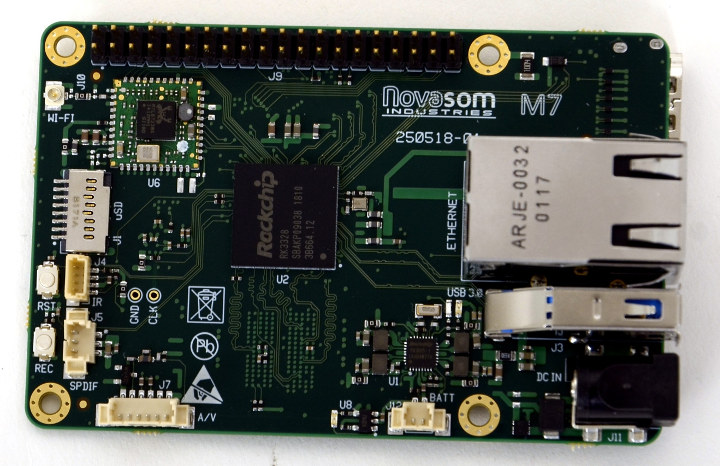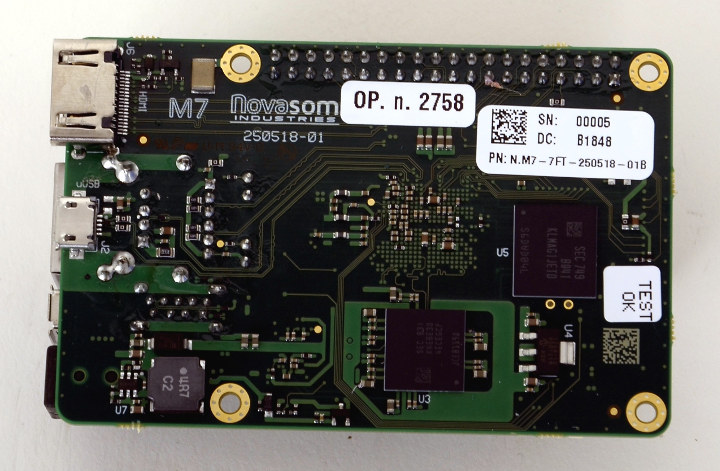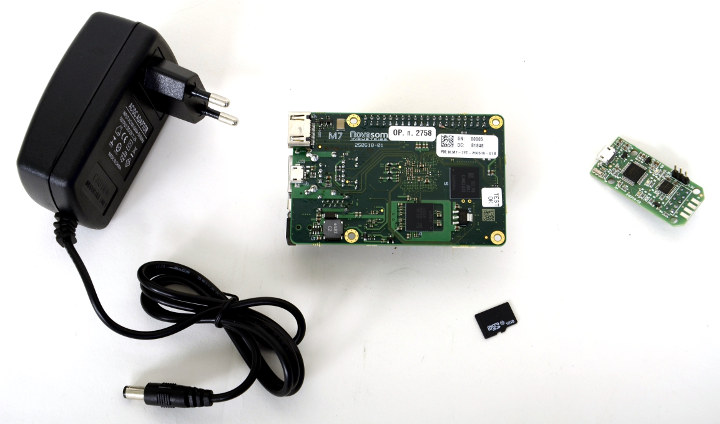Raspberry Pi boards are great for education and hobbyist projects, and while they are also found in industrial projects, they may not be the ideal solution for such commercial projects because of potential availability issues, stability issues in demanding environments, lack of certifications, and lack of commercial support.
Novasom RASPMOOD family of SBCs aims to provide a drop-in replacement for Raspberry Pi based designs by providing mechanically and electrically compatible boards, as well as a software layer that allows the RASPMOOD boards to leverage the software you’ve already developed for your Raspberry Pi 3 design.

Today we’ll specifically look at Novasom M7 “RASPMOOD” board – aka SBC-M7 – powered by a Rockchip RK3328 processor.
Specifications:
- SoC – Rockchip RK3328 quad core Cortex-A53 processor with Mali-450MP4 GPU
- System Memory – Up to 4 GB DDR3 RAM
- Storage – Up to 256 GB eMMC Flash + uSD slot
- Video Output – HDMI 2.0 to to 4K @ 60 Hz, LVDS via external adapter, PCAP on Connector (dedicated I2C port)
- Camera – Parallel camera support
- Audio – Analog line out
- Connectivity – 10/100M Ethernet, optional 802.11a/b/g/n WiFi with PCB antenna
- USB – 1 x USB 3.0, 1 x USB 2.0, 1x micro USB OTG port
- Expansion – 40-pin Raspberry Pi compatible header with 2x I2C @ 3.3 V, 1x SPI, 22x GPIO @ 1.8V
- Debugging – TTL debug port
- Misc – 1x user LED, RTC with external rechargeable battery , user reset push-button
- Power Supply – 12V (6.5 to 18V protected); UPS manager (battery not included)
- Dimensions – 86 x 54 mm
- Temperature Range – 0 to 70°C

First obvious remark: the board is not 100% mechanically compatible with Raspberry Pi 3 board so you may have to redesign part of your enclosure / mechanical design. The mounting holes and the 40-pin header positions are the same, but for example USB and HDMI ports are placed differently.
The company provides support for Debian (Armbian), as well as Android 7.1/8.1. The company explains that one major difference is that they customized the kernel in such a way that the SW is 100% loaded in RAM and the uSD is used only at the bootstrap, which means the uSD card should not wear out after few months. Novaembed SDK allows users to easily configure the Linux OS with a GUI tool.
Several variants of the board are available with all options, no WiFi/Bluetooth, only 1GB RAM, no variable power supply input support, and no eMMC flash. Customers will usually ask the company to customize the board’s options to meet their needs, so the price will depend on options and order quantity. There’s also the DK-M7FT development kit with the board and several accessories as pictured below.

Novacom has several families of those Raspmood boards with the M-Line featuring the Novasom M7 discussed in this post, as well as the similar Snapdragon 410E based M8 board both of which target multimedia applications such as digital signage. The U-Line family targets applications with lower processing needs and RGB displays (no HDMI port) with for example NXP i.MX6ULL based U5-SBC board. More boards and details can be found in Novasom Arm’s SBC products page.

Jean-Luc started CNX Software in 2010 as a part-time endeavor, before quitting his job as a software engineering manager, and starting to write daily news, and reviews full time later in 2011.
Support CNX Software! Donate via cryptocurrencies, become a Patron on Patreon, or purchase goods on Amazon or Aliexpress




